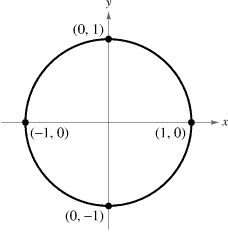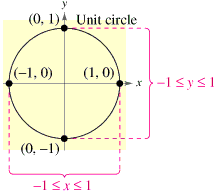Unit Circles |
Consider the unit circle given by the equation
x² + y² = 1. The radius is therefore 1. The
equation of the arc length of an angle is s = r where s is the arc length, r is the radius, and ? is the
central angle. When the radius is 1, the arc length equals
the angle. Using unit circles makes it easier to relate
to real life applications.
where s is the arc length, r is the radius, and ? is the
central angle. When the radius is 1, the arc length equals
the angle. Using unit circles makes it easier to relate
to real life applications. |
 |
Trigonometric Functions
|
Consider the unit circle given by the equation
x² + y² = 1. The radius is therefore 1. The
equation of the arc length of an angle is s = r where s is the arc length, r is the radius, and
where s is the arc length, r is the radius, and  is the central angle. When the radius is 1, the arc length
equals the angle. Using unit circles makes it easier to
relate to real life applications.
is the central angle. When the radius is 1, the arc length
equals the angle. Using unit circles makes it easier to
relate to real life applications. |
Definitions of Trigonometric Functions:
|
Let t be a real number and let (x, y) be
the point on the unit circle corresponding to the angle
t.
sin t = y
cos t = x
tan t = y/x x  0
0
csc t = 1/y y  0
0
sec t = 1/x x  0
0
cot t = x/y y  0
0
Cosecant, secant, and cotangent are the reciprocals of
sine, cosine, and tangent respectively. The tangent and
secant of t are not defined when x = 0. This is shown
in the following examples:
t =  /2 corresponds
to (0, 1) because cos( /2 corresponds
to (0, 1) because cos( /2)
= 0 and sin( /2)
= 0 and sin( /2)
= 1, it follows that tan( /2)
= 1, it follows that tan( /2)
and sec( /2)
and sec( /2)
are undefined. The cotangent and cosecant functions are
also undefined when y = 0. /2)
are undefined. The cotangent and cosecant functions are
also undefined when y = 0.
t = 0 corresponds to (1,0), therefore cot 0 and csc 0
are undefined. |
Domain and Period
|
| The domain of the sine and cosine functions
is the set of real x values that fall on the function.
Remember that r = 1, sin t = y, and cos t = x. As the
radius is 1, |
| |
|
| -1 = y = 1 |
-1 = x = 1 |
Therefore the values of sine and cosine also range
between -1 and 1: |
| |
|
| -1 = sin t = 1 |
-1 = cos t = 1 |
|
Adding 2 to each value of t completes another full revolution around
the unit circle. Therefore, the values of sin(t + 2
to each value of t completes another full revolution around
the unit circle. Therefore, the values of sin(t + 2 )
and cos(t + 2 )
and cos(t + 2 )
correspond to those of sin t and cos t. Adding any multiple
of 2p, positive or negative, will yield the same results.
This means that: )
correspond to those of sin t and cos t. Adding any multiple
of 2p, positive or negative, will yield the same results.
This means that:
sin(t + 2 n)
= sin t and cos(t + 2 n)
= sin t and cos(t + 2 n)
cos t n)
cos t
for any integer n and real number t. Functions that repeat
in cycles like this are called periodic. A function is
periodic if there is a positive number c such that
f(t +c) = f(t)
The smallest number c that makes f periodic is called
the period of f. It is shifted by c so that after the
shift it the same as the original function. |
 |
Even and Odd Trigonometric Functions
|
The cosine and secant functions are even.
cos(-t) = cos t sec(-t) = sec t
The sine, cosecant, tangent, and cotangent functions are
odd.
sin(-t) = -sin t csc(-t) = -csc t
tan(-t) = -tan t cot(-t) = -cot t |


